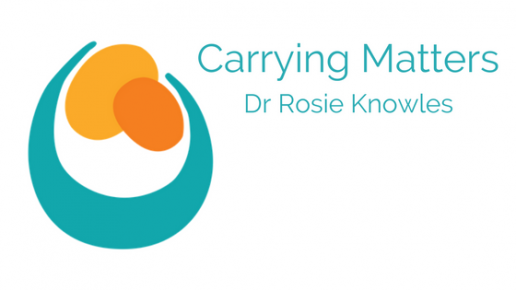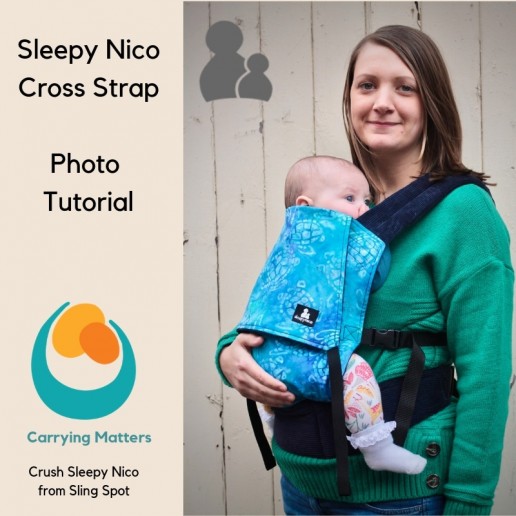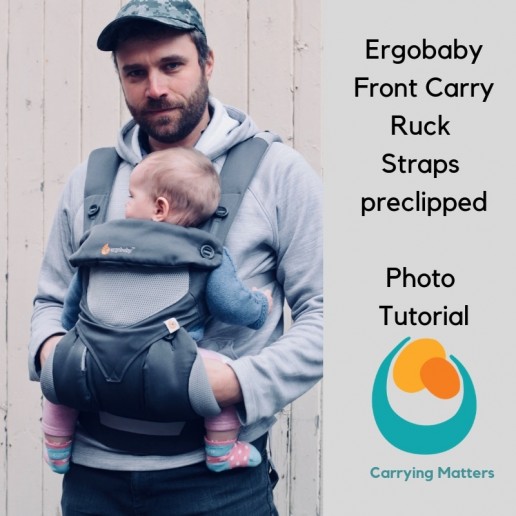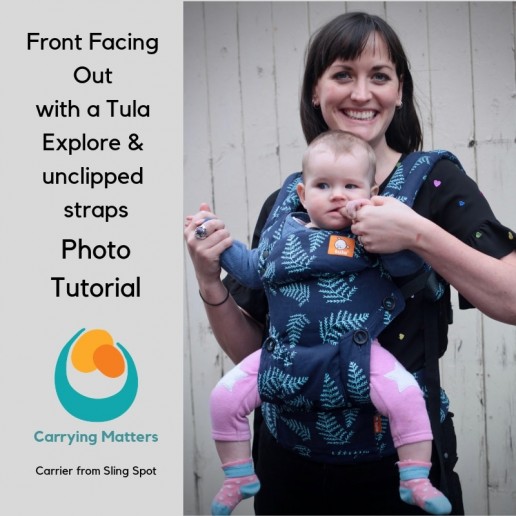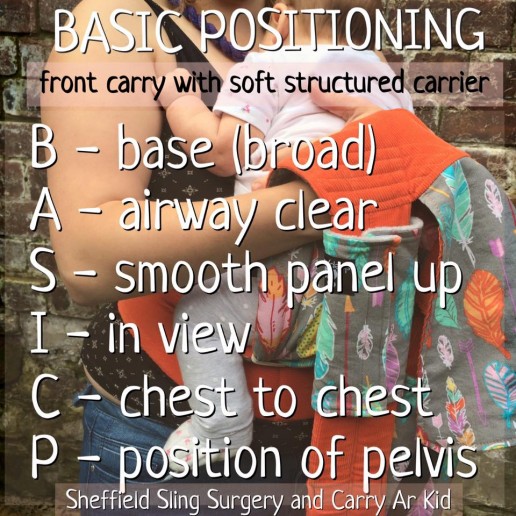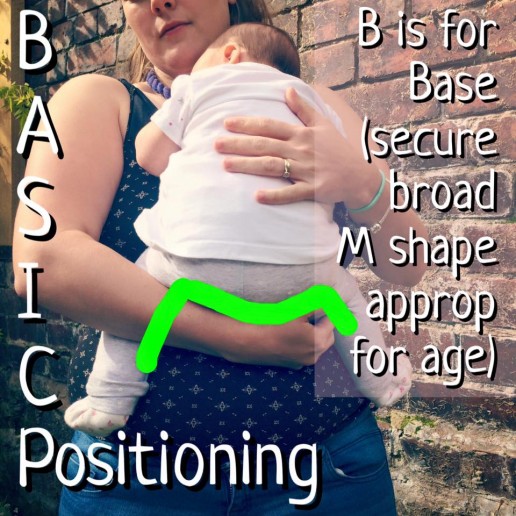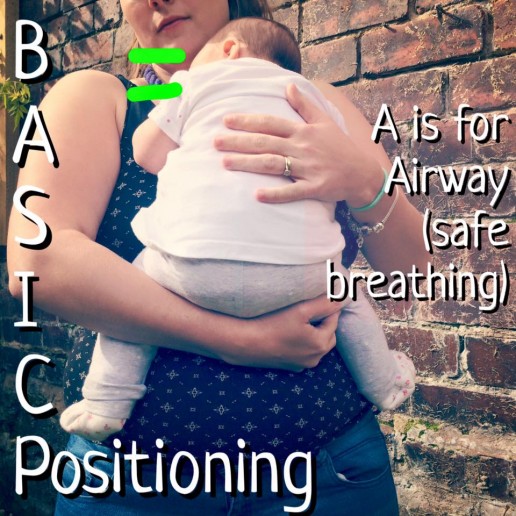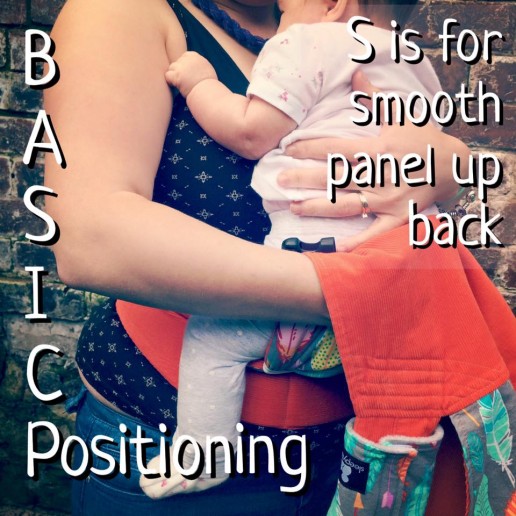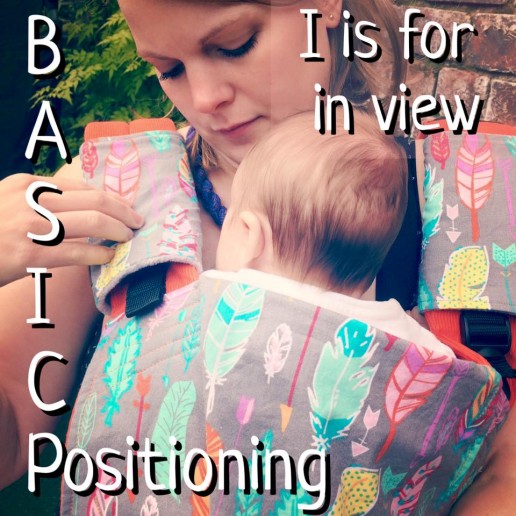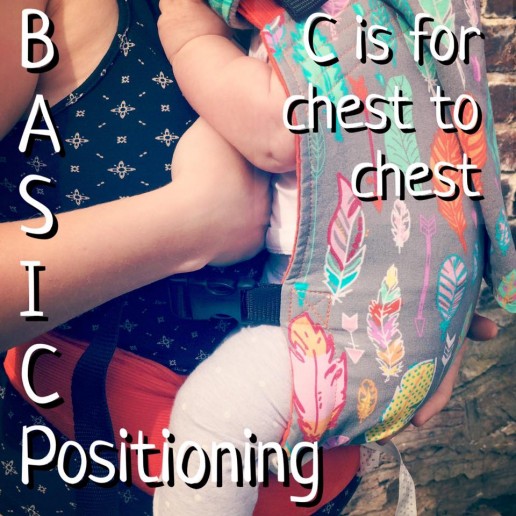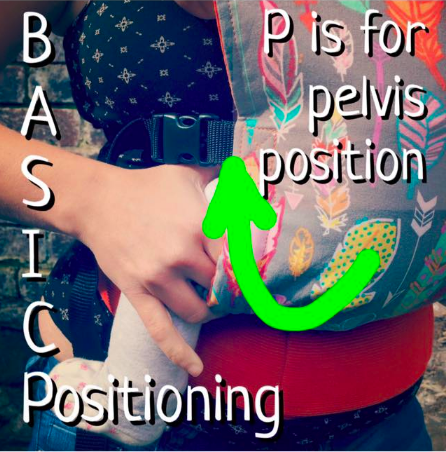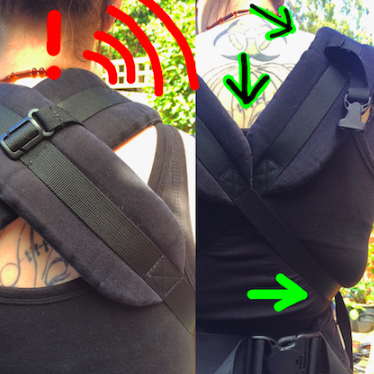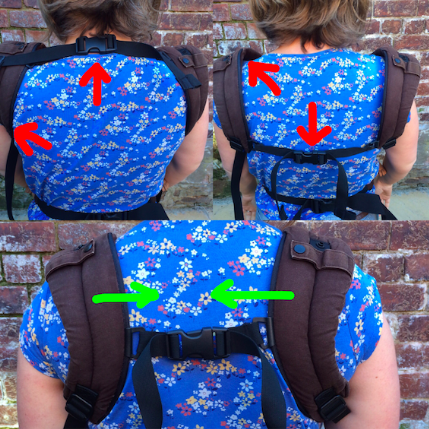Buckle carriers are perhaps the most well-known type of carriers in our Western society. They are popular for their perceived simplicity and ease of use, as well as their convenience in bad weather! There are many types of buckled carrier. The most useful ones are designed to be respectful to baby and parent’s anatomy as well as comfortable for long periods of time.
Like all carriers, buckled carriers need to be used safely and the TICKS guidelines should always be followed. The most important consideration is to protect baby’s airway; a baby should be held snugly chest to parent, the neck should never be folded in half and two fingers should fit between their chin and their chest. Neither should they be leaning away with a gap between themselves and their parent. A carrier that swings free when parent leans forwards is not a safe one.
The most frequently adopted, anatomically respectful position for carrying young babies is upright and facing the parent, with legs slightly spread apart (the M position) and head well supported against parent’s chest, as this will also protect growing hips and spine. Awake babies will look around, then regather their strength by resting their head on the parent’s chest for a short while; this is the safest way to carry, rather than leaning back loosely into a large head-rest.
“Quick and easy to use.” “Super comfy when they are adjusted well and fit properly.” ” So much easier to use when I have mobility problems with my hands.” “Dad and family friendly.” “Easy in the rain."
Anatomically correct positioning in a gentle J shape
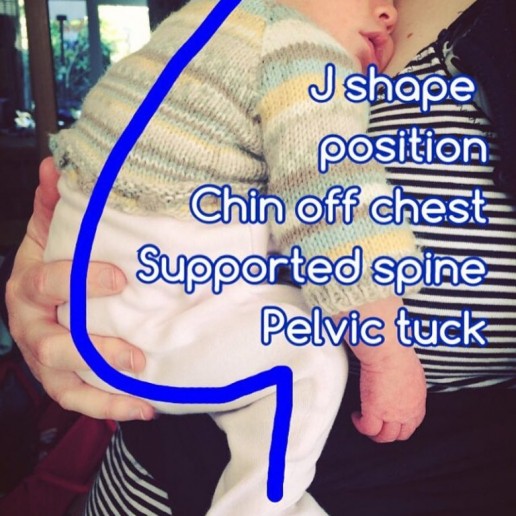
The buckle carrier has a structured panel, often a waistband, and two shoulder straps that all buckles together to hold the child close to the carer’s body. Good full buckle carriers are designed to keep baby snugly close and high up (close enough to kiss) and ensure the airway is protected for safe breathing. A baby should never be loose enough to swing free when parent leans forwards. They should not be too tall for the baby – too tall carriers or an over-focus on “head support” can cause airway issues.
Good buckled carriers should ensure baby’s spine is able to curve gently into the natural fetal tuck with the knees above the bottom that is so comfortable and natural for babies and children, thereby supporting them gently from the kneepits up to the back of the head (with head support if needed for those who want to look around).
Carriers like this are usually very comfortable for the caregiver, so much so that children are often carried happily and contentedly well into the toddler years and beyond (as compared to typical narrow-based high street brands which can feel uncomfortable quite quickly).
What kind of buckle carriers are there?
There are many variants on the basic model, such as the type and structure of the waistband, the way the straps fasten (cross straps or rucksack straps), and the height and width of the panel. Some carriers can be adjusted to fit younger or older babies while some have separate inserts for newborns.
Generalisations such as “you need a carrier with a waistband for support if you have back pain” or “you’d be better off with a carrier that crosses the straps if you want to front carry” can be unhelpful.
Each parent-child dyad is unique and it is ALL about how each carrier distributes the weight around the body, which varies enormously from parent to parent, and also from child to child. An adult’s body shows its history as it stands; how active it has been, how sedentary, any injuries, any chronic postural habits. When you load this body with a baby, all sorts of mechanics come into play, such as the convergence or divergence of centres of gravity, which joints end up being loaded and at which angles, and so on.
Babies themselves play a part in being carried; they may be more or less active participants. Sleeping babies or those who have “low tone” are harder to carry, as are those who are wriggling and twisting and turning to be able to see past straps too close to their faces.
One size does not fit all, and this is why sling libraries, sling meets and sling consultants exist, to give parents a chance to identify what fits their baby, their own physiology and their circumstances best. You can read more about how to choose a sling here.
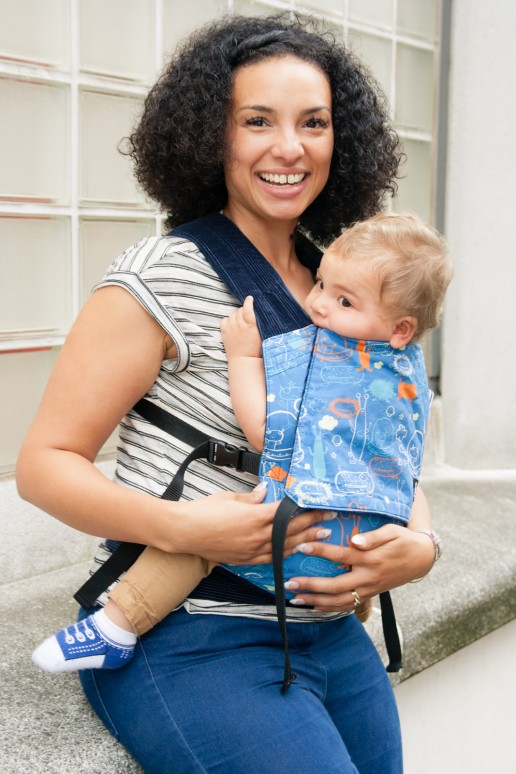
Crossed straps, soft padded waistband

Cross strap carrier with soft panel
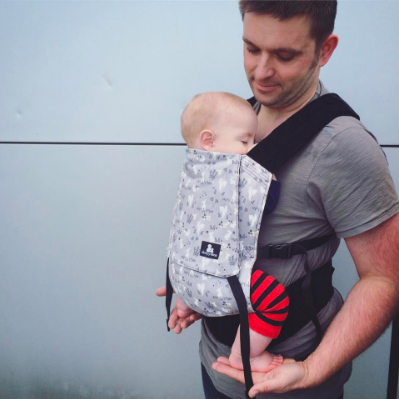
Rucksack straps with padded waistband
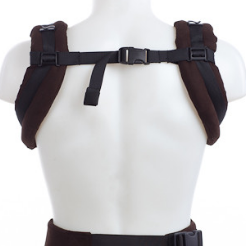
Rucksack straps, firm padded waistband
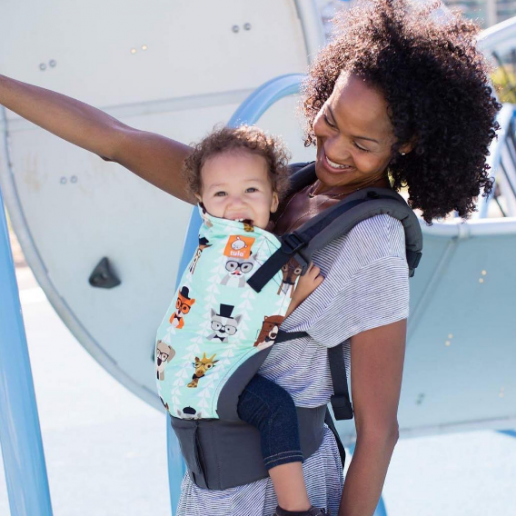
Adjusting buckle carriers for newborns
On the whole, most buckle carriers fit babies from three months upwards, and stretchy wraps or ring slings can be more useful with newborns. However, there are a few full buckle carriers that can be used from birth, which have adaptations or inbuilt support structures for babies of 7-8lb and upwards.
Some have unpadded webbing waistbands that can be rolled and cinched with straps to fit baby’s smaller knee to knee spread and narrower torso while they are small, and be gradually widened as baby’s legs grow longer. Others have foldable corners that can be poppered into a narrower shape for little legs; all can be widened as baby grows to ensure there is always a good fit while hips are still growing and forming.
Using inserts with newborns
Many other carriers have separate inserts to make the volume inside the panel smaller. Baby perches on the insert in the seated squat position, and the panel is brought up over their backs. Small babies may need the “back” section of the insert to hold their little bodies securely inside the wide panel. Here is a a handy photo tutorial for how to use an insert.Here is a a handy photo tutorial for how to use an insert.
Inserts can feel very warm in hotter weather, so do dress your baby carefully and ensure they don’t overheat.
Many people will find that they enjoy buckle carriers most once their small babies have grown a little bit stronger with more muscle tone and a little bit of head control (around three months), but with care and attention, young babies can be carried safely. Always remember that baby must not be slumped over to one side or folded in half.
Unpadded waistband, carrier "cinched" in for a perfect fit
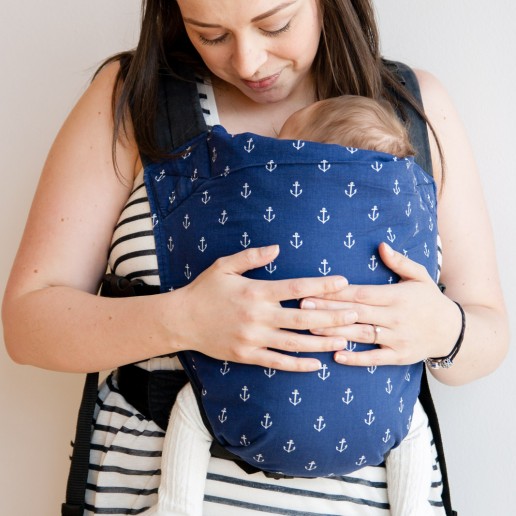
Baby seated on insert, about to have panel brought up
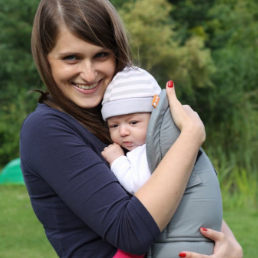
Unpadded waistband, carrier "cinched" in for a perfect fit

Baby seated on insert, about to have panel brought up

“Convenient for toddlers who are up and down all day.”“Good with wriggly children.” “Easy to buy from mainstream sellers.” “So easy to use.” “Useful accessories like a hood for bad weather.” “Pretty foolproof for a newbie.” “Great for travelling.” “Really easy to get my child clipped in and out while on the bus.”
What positions are best with buckle carriers?
Newborns and young babies under four months should be held facing in towards their caregivers. Thus position allows good airway, spine and hip support for babies who have not yet developed significant muscle strength and endurance, and who still have the curved spines of infancy. This keeps them safe. Babies should not have their spines artificially straightened but should be held in their natural fetal tuck, the M and J shape as seen from the back and from the side.
This “seated squat” position is a safe position to sleep when needed; heavy little heads resting against a carer’s chest with free airflow and not buried deep in cleavage. This is why “close enough to kiss” matters.The facing-in position keeps the baby and caregiver’s centres of gravity as close together as possible for greater all-round longer lasting comfort. Weight is distributed better around the body as baby curls in, rather than the parent needing to lean back to offset the weight hanging from the front.
Lastly, being able to see the parent can allow active “social referencing”. This is also known as “triangulation” – where a baby experiences something in her field of vision and is able to turn to see what her caregiver makes of this same experience – three corners of a triangle, environment, baby, caregiver. This allows baby to assess and process a new experience in the light of her caregiver’s response, thereby allowing learning from a “safe place”.
Manufacturers usually suggest short periods of time for facing out for those with good head control, this is usually four months at the least, due to the fatiguability of young muscles, and the time it takes for the infant brain to learn how to focus on one stream of information and zone the rest out. A child should never sleep facing out, as this can pose a risk to airway.
There are now some more thoughtfully designed carriers on the market that allow both facing in and out and provide better seated positions and thus great comfort for both parent and child. Furthermore, carriers with wider top panels will allow an elbow and shoulder to move freely which increases a child’s visibility enormously.
Some buckle carriers can also be used on the hip (some are designed specifically for this) and many will also carry on the back.
Read more about facing out carrying here
Facing out with a wider hip position
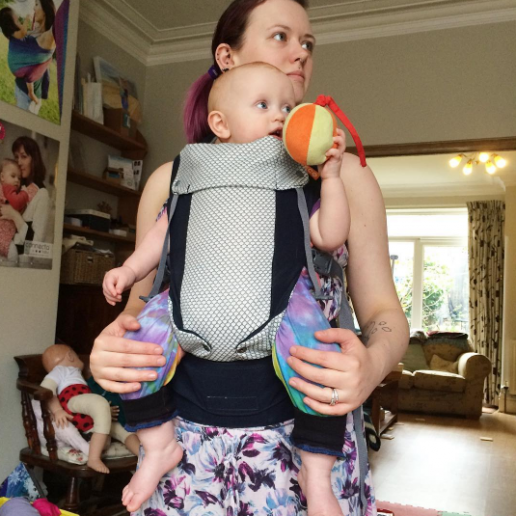
Facing out in a seated position
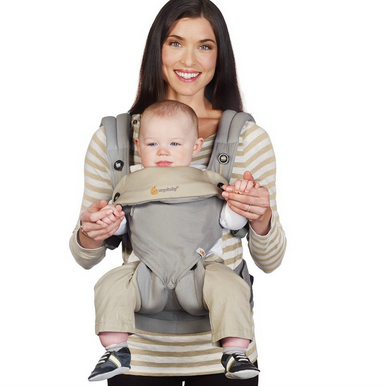
Arms out and facing in
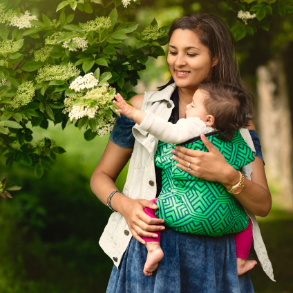
“We love how convenient it is. You can just pop him in and go. It’s the easiest way of doing short journeys where you’re taking him in and out lots. If I could only have one sling, it’d be a ring sling.”
How do I put my cross strap buckle carrier on?
Having trouble with the shoulder straps creeping to your neck? Read our guide to fixing this here.
Here is a video to show you how to do the pelvic scoop/tuck with a buckle carrier.
The pelvic tuck/scoop technique of encouraging a child to sit in a position that creates a “J shape” (from the side) or an “M shape” (from the front) in a carrier is very helpful. Such positioning is more comfortable, more respectful of anatomy, and also helps preserve open airways. The aim is to raise the knees up, allowing the bottom to settle downwards into the classic “M shape”. Read more here.
Top Tips!
- Work on your waistband; have it parallel to the ground.
- Hold your baby straight in the centre of your chest, not slipping to the side.
- Make sure he is sitting in the M shape and hold his chest close to you as you go. Getting position right at the beginning makes it much easier later.
- Bring the panel up smoothly, keeping him close.
- Keep arms in if possible, and bring older babies' arms out later, once the carry is finished. Toddlers may prefer being carried arms out from the start; ensure the panel comes right up under their armpits.
- Practice tightening your straps; become familiar with them first so you can get them snug.
- Always tighten webbing in parallel to itself or it will be a struggle to remove slack.
- Lift your baby's bottom with one hand as you tighten straps, this may make it easier (as you are not pulling their whole weight).
- Keep the straps wider on your shoulders if you can.
- The key thing is to keep baby close and high; low and loose causes strain and can lead to discomfort for you. If you are uncomfortable, come and get some help.
Common Queries about Buckle Carriers
Feeding in buckle carriers
Feeding is possible in buckle carriers worn on the front, with a little care to ensure baby’s airway is well protected. Typically, for breastfeeding, this involves loosening the panel in stages so baby is lowered gently to the nipple. No breastfeeding is hands free, and it is usually a good idea to get some help and advice from people who are familiar with how to do it. Please note that when baby has finished feeding, he must be returned to his safe snug upright position, close enough to kiss.
You can read more about how to breast and bottle feed here.
Bottle feeding in a buckle
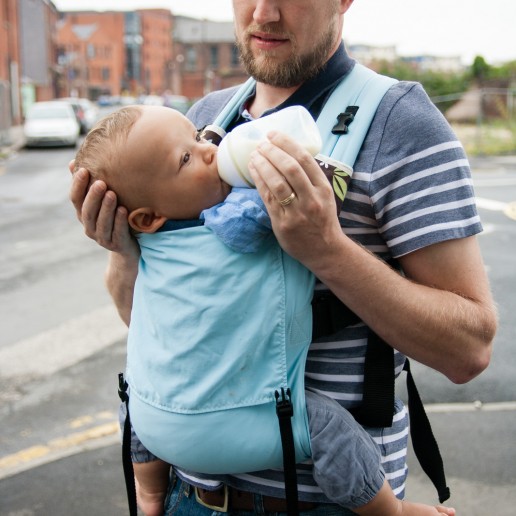
When can I start back carrying with my buckle?
Many families love this way of carrying an older baby, and it also allows the child to see where they are going when carried!
On the whole, most people feel that the best time to begin back carrying in structured panelled carriers is when baby’s upper body and torso muscles are strong enough. They need to have enough endurance to be consistently able to support themselves and hold their heads upright for a significant amount of time without tiring. This typically occurs when babies are beginning to sit unaided (or nearly). This commonly happens around six months, on average – it varies from child to child. This is in contrast to wraps or floppy meh dais (formerly known as mei tais) as these can be controlled and tightened carefully to mould around baby’s body, to ensure neck support to heavy heads.)
Some children may take longer to develop upper body control, but their parents may be struggling to carry them on the front; do go and get some help from a professional who can help you find some solutions to this problem and keep you carrying. Generally, if the carrier fits your child properly and provides the necessary support with no slumping when a hand is not available for support, you can back carry in it. This will apply to children with disabilities for example; it can take longer to gain head control but back carrying may be important. This may also apply to twin carrying, where a parent just needs to survive. The right carrier that fits well and is used optimally may work just fine.
Read more here about beginning to back carry.

